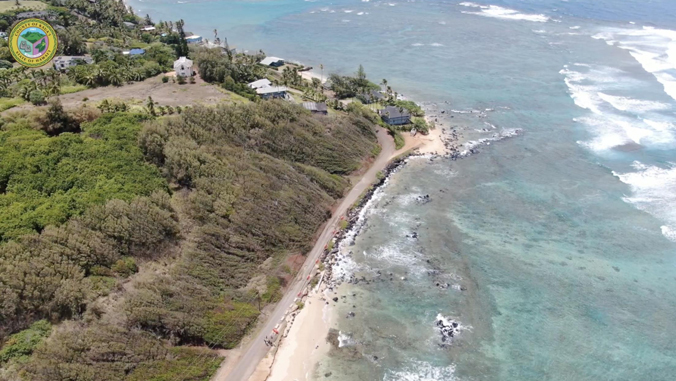
Kauaʻi is one of the first counties in the nation to use scientific modeling to integrate climate change hazards into zoning and land use regulations.
For a new ordinance that utilized data from the University of Hawaiʻi Mānoa’s Climate Resilience Collaborative (CRC) to determine elevations for future safe building construction on Kauaʻi to avoid impacts from sea-level rise, the County of Kauaʻi Planning Department received the American Planning Association’s (APA) 2023 National Resilience & Sustainability Award. The county’s legislation is called the Kauaʻi Sea Level Rise Constraint District Ordinance.
“Kauaʻi County has made it a priority to base their development policies on solid scientific modeling,” said Chip Fletcher, interim dean of the UH Mānoa School of Ocean and Earth Science and Technology and director of CRC. “The University of Hawaiʻi at Mānoa is proud to continue working with this progressive administration who puts public health and safety as their first priority.”

Only one planning program nationwide is selected annually for this award, recognizing the exemplary work of planners to build policies or plans addressing resiliency and sustainability.
“We are incredibly proud of our Planning Department and all involved in this groundbreaking ordinance that was signed into law just last year,” said Mayor Derek S.K. Kawakami. “Kauaʻi is no stranger to coastal erosion and flooding, as we’ve seen first-hand how climate change is affecting our community. We thank APA for acknowledging our hardworking associates and their progressive and innovative efforts to ensure a better future of our island and people.”
Tiffany Anderson, assistant researcher with CRC, developed computer models that identified potential future flood depths due to rising sea levels and wave inundation on Kauaʻi. This information was incorporated into Kauaʻi County’s Sea Level Rise Constraint District within its Comprehensive Zoning Ordinance as a proactive measure to enhance community resilience and reduce risk to the built environment. This measure was formally adopted in October 2022.
“It’s hard to be the first to do anything, and the County of Kauaʻi demonstrated that they truly believe in the people of Kauaʻi‘s ability to grow and adapt to changes in our environment,” said Anderson. “Kauaʻi County planners talked with community members to make sure that local people’s voices were heard, and then they created a process that was very transparent, straightforward, and non-disruptive to current building procedures.”
“Coastal communities are particularly vulnerable to devastating climate impacts. Utilizing scientific studies and mapping done by the University of Hawaiʻi’s Climate Resilience Collaborative, we were able to craft new land use and building design regulations,” said Kauaʻi Planning Director Kaʻāina Hull. “Mahalo to APA for this award, particularly recognizing the need for scientific modeling within zoning regulations to address municipalities that are increasingly finding themselves under threat by the various hazards of our changing climates.”
First county to implement scientific modeling
The passage of the Sea Level Rise Constraint District bill is the culmination of nearly five years of scientific study, community engagement and stakeholder input. The Constraint District is also unique in its integration of Geographic Information Systems-based modeling.
APA recognized Kauaʻi’s Sea Level Rise Constraint District as a proactive model that minimizes the threat to public health and safety, promotes resilient planning and design, and reduces expenditure of public monies for costly flood control projects.
“By acting thoughtfully and decisively to locate new structures out of harm’s way, the County of Kauaʻi provides an important example of how to make our communities safer and reduce the damage and costs of a changing climate,” said Ben Hitchings, 2023 APA Awards jury chair. “The effective use of scientific data and web-based technology to support this initiative creates a transparent and innovative approach that others can emulate.”

